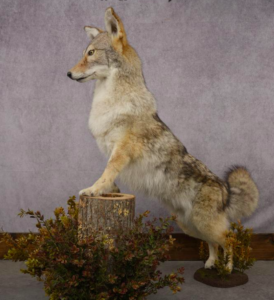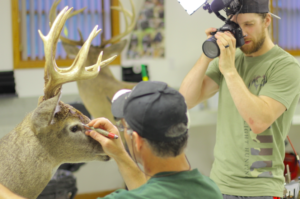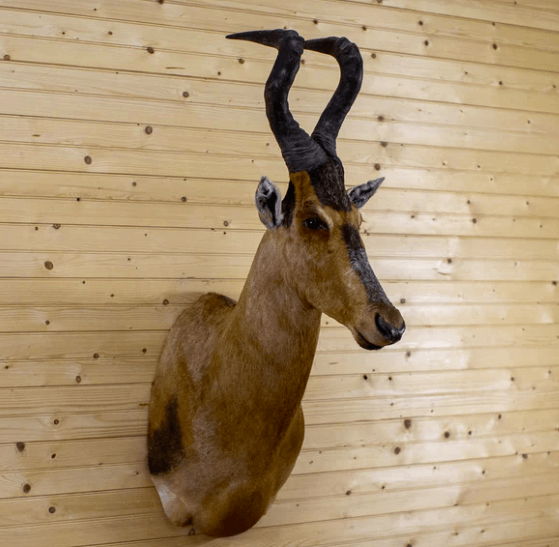
Red Hartebeest : Timeless Beauty.
Certain trophies transcend ordinary prestige symbols in the world of hunting and wildlife lovers, becoming living testaments to the enchanting grandeur of the African savannas. Among these gems is the Red Hartebeest mount, an artistic tribute to one of Africa’s most magnificent antelope species. Red Hartebeest mounts are a monument to the age-old talent of taxidermy, capturing the essence of the broad plains and conserving the beauty of these beautiful creatures for future generations.
Red Hartebeests have long captivated the minds of hunters and nature enthusiasts alike, with their elongated features, prominent horns, and elegant walk. Each beautifully carved mount offers a story of adventure, expertise, and a genuine admiration for Africa’s abundant variety.
explore the creativity behind these masterpieces, their cultural importance, and the everlasting fascination of bringing the spirit of the savannas into our homes as we dig into the world of Red Hartebeest. Explore the creativity and workmanship that celebrates the everlasting beauty of the Red Hartebeest, permanently captured in a moment of creative preservation.
Best Red hartebeest Mounts for sale from Taxidemist.
1- African Red Hartebeest Shoulder Mount for Sale
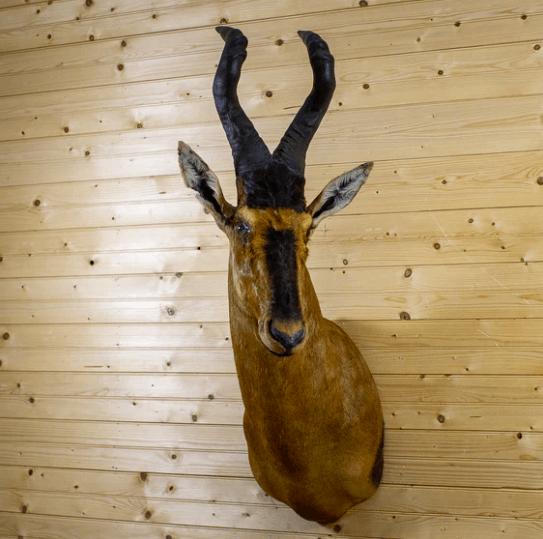
The red hartebeest is one of Africa’s great traditional hunting trophies. Although not officially scored or awarded, with a total score of 62 4/8″, this specimen would qualify for SCI Bronze. Both the left and right horns measure 10 6/8″ in circumference and 20 4/8″ in length.
We have given this mount our Premier rating because of its beauty, craftsmanship, and SCI Bronze size. This item would look wonderful in your man cave, woman shed, cigar or whisky room or as a discussion piece in your living room or workplace.
Size: 46″ tall x 14″ wide x 24″ deep.
Weight: approx 28 lbs.
Hangs from a single, well-mounted screw by its included hardware.
Ships for FREE in the Continental U.S.!
Price…$1,589
2- Perfect African Red Hartebeest Taxidermy Shoulder
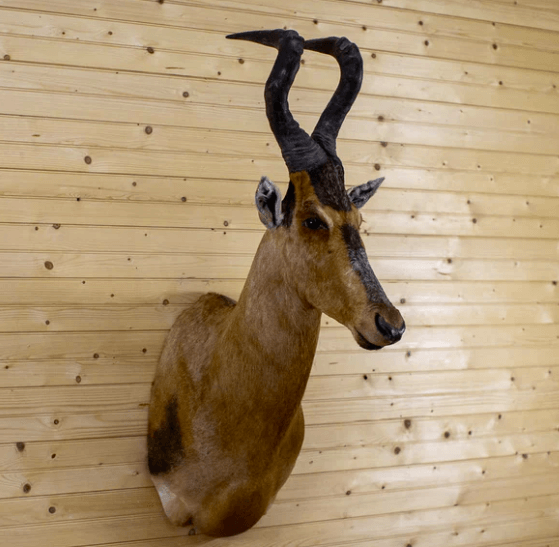
He is posed with his head raised and a peaceful smile on his face, slightly turned to the viewer’s right. Excellent addition to your taxidermy trophy collection or as a unique discussion piece in your living room or workplace.
One of Africa’s great legendary hunting trophies. The workmanship, colouring, and horns on this African Red Hartebeest taxidermy shoulder mount are exceptional. As a consequence, it obtains our Excellent quality rating. have Large horns with thick bases.
Size: 46″ tall x 14″ wide x 27.5″ deep.
Weight: approx 20 lbs.
Wall hanger is attached. Hangs from single, well-mounted, heavy duty screw.
Ships free!
Price…$989
3- African Red Hartebeest Taxidermy Mount – SW10157
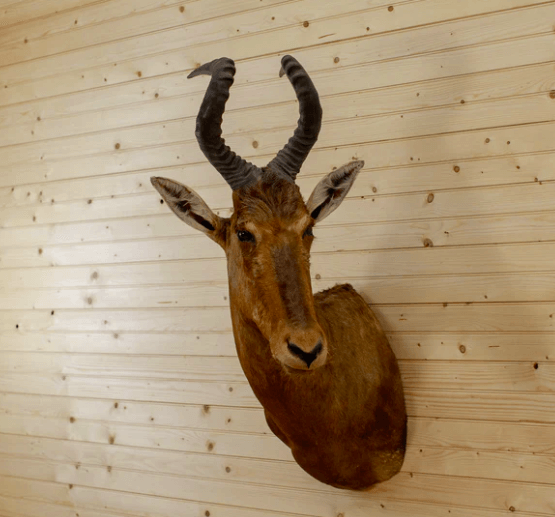
- One of Africa’s great legendary hunting trophies. The workmanship, colouring, and horns on this African Red Hartebeest taxidermy shoulder mount are exceptional. As a consequence, it obtains our Excellent quality rating. Large horns with thick bases. A great conversation piece or addition to your taxidermy trophy collection.
- Alcelaphus caama is the scientific name for this plant.
- Dimensions: 39″ tall x 17 1/2″ broad x 25″ deep.
- Weight: around 20 lbs.
Price…$975
4. Red Cape Hartebeest Shoulder Mount for sale

A stunning Red Cape Hartebeest shoulder taxidermy mount, sitting erect and facing the viewer’s left side out into the room. This Hartebeest has magnificent red hair, superb taxidermy artistry, and an amazing pair of horns, earning it a Safari Club International Bronze Medal with a score of 64 0/8″.
All relevant measures and dimensions are supplied in the specs section to assist guarantee that this item will fit inside your planned location and match your expectations for the item’s featured attribute sizes, scores, and so on.
- The Red Cape Hartebeest scored higher than the Safari Club International Bronze Medal prize book criteria.
- This item already has a hanger attached to the back.
- It will be supported by a single well secured plasterboard screw.
Price…$1,395
5. Red Hartebeest Shoulder Mount for Sale

This Hartebeest has magnificent red hair, amazing taxidermy skill, and a great set of horns, earning it a Safari Club International Bronze Medal with a score of 62 7/8″. All relevant measures and dimensions are supplied in the specs section to assist guarantee that this item will fit inside your planned location and match your expectations for the item’s featured attribute sizes, scores, and so on.
- The Red Cape Hartebeest scored higher than the Safari Club International Bronze Medal prize book criteria.
- This item already has a hanger attached to the back.
- It will be supported by a single well secured plasterboard screw.
Price…$1,295
What exactly is a Red Hartebeest?
The Red Hartebeest (Alcelaphus buselaphus caama) is a big and unique antelope species endemic to southern African grasslands and savannas. It is a member of the Alcelaphinae subfamily of the Bovidae family, which contains other hartebeest and wildebeest species.
The Red Hartebeest is easily identified by its distinct look, which is defined by a combination of physical characteristics. It has a slender, long-legged physique and a reddish-brown to tawny coat that helps it blend in with its grassland environment. The term “hartebeest” is derived from the Afrikaans words “harte” (heart) and “bees” (ox), and refers to the skull’s unusual form, which resembles a “heart” when viewed from the side.
The Red Hartebeest’s extended face and prominent forehead are two of its most distinguishing characteristics, giving it an almost archaic look. Large, widely separated eyes and tall, sharply curved horns that sweep backward provide efficient defence against predators on the face.
These antelopes are gregarious creatures that create herds of females and their young, while adult males might be alone or form bachelor groups. During the mating season, powerful males compete fiercely for dominance and mating privileges.
What is a Red hartebeest mount?
A Red Hartebeest mount is a taxidermied exhibit of the Red Hartebeest, a huge and beautiful antelope species found in Southern Africa. Taxidermy is the art and practise of conserving an animal’s body and displaying it in a lifelike shape for display. Hunters, wildlife lovers, and collectors can have the animal’s hide and horns preserved and mounted by a skilled taxidermist.
Mounted Red Hartebeest may be seen in a variety of venues, including hunting lodges, museums, nature centres, and private collections, where they serve as both ornamental pieces and educational exhibitions exhibiting the beauty and diversity of African wildlife.
What do Red Hartebeest eat?

Red Hartebeests are herbivorous creatures that eat grasses as their primary source of nutrition. They graze primarily on grasses found in their native environment, which is often the broad grasslands and savannas of southern Africa.
They eat a variety of grasses, including Rhodes grass, red grass, star grass, and other succulent grasses. They have evolved to absorb and digest the nutrient-rich grasses that comprise the majority of their diet.
Red Hartebeests typically feed on young green grass shoots during the rainy season, when grasses are more numerous. During the dry season, when grass is scarce, they may resort to eating on dried grass or plants.
Red Hartebeest hunting locations
Due of their conservation status, the Red Hartebeest is a protected species in several locations. They may be found in a number of southern African nations, including South Africa, Namibia, Botswana, and Zimbabwe. If you want to hunt Red Hartebeest, I strongly suggest you to do your homework and contact reliable hunting outfitters or agencies in the area or region where you want to hunt.
Professional hunting outfitters can offer you with important information on hunting rules, hunting seasons, approved areas, and other data that will guarantee your hunting activities are legal and sustainable.
Remember that responsible and ethical hunting practises are critical for preserving animal populations and habitats for future generations to enjoy.
FAQs
Q: How should I look after and preserve my Red Hartebeest mount?
A: To ensure their longevity, Red Hartebeest mounts must be properly cared for and maintained. Maintain a safe distance between them and direct sunshine, dampness, and pests. Dust and clean the mount on a regular basis using a gentle brush or cloth. On the hide, avoid using cleaning chemicals or water. Consult a skilled taxidermist for repair if the mount exhibits signs of wear.
Q: Can I bring a Red Hartebeest mount from another country?
A: Taxidermy specimen import and export rules differ per country, including those for Red Hartebeest mounts. Before attempting to transfer a taxidermy mount across borders, it is critical to investigate and comply with both the country of origin and destination’s customs and wildlife import/export rules.
Q: What is the habitat of the Red Hartebeest?
A: Red Hartebeests live in southern Africa’s broad grasslands and savannas
Q: How fast can Red Hartebeests run?
A: Red Hartebeests are famous for their speed and endurance. When fleeing from predators, they may achieve speeds of up to 50 to 55 kilometres per hour (31 to 34 miles per hour).
Q: When is the Red Hartebeest breeding season?
A: The breeding season for Red Hartebeests varies by area, although it usually takes place during the rainy season, when food is plentiful. Calves are normally born following an 8-month gestation period.
Q: How long do Red Hartebeests typically live in the wild?
A: Red Hartebeests have an average lifetime of 12 to 15 years in the wild. However, predation, ecological conditions, and access to nutrients can all have an impact on their lifetime.
Q: Do Red Hartebeests migrate?
A: Unlike several other African antelope species, Red Hartebeests are not known for long-distance migrations. However, within their native range, they may display seasonal migrations, particularly in reaction to changes in food supply and water supplies.
Q: Do Red Hartebeests have the ability to hybridise with other antelope species?
A: Interbreeding has been reported between several hartebeest species and even with wildebeests (gnus). These hybrid progeny are commonly known as “tora” or “swartland” hartebeests.
Related

